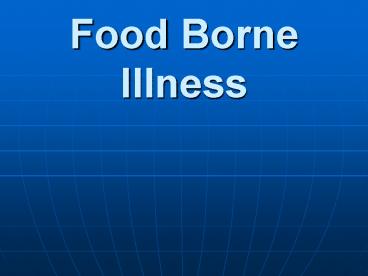Food Borne Illness - PowerPoint PPT Presentation
Title:
Food Borne Illness
Description:
Food Borne Illness Clostridium perfringens Two syndromes diarrhoea and pig-bel (necrotizing enteritis) The organism large, non-motile G+ve, anaerobic ... – PowerPoint PPT presentation
Number of Views:135
Avg rating:3.0/5.0
Title: Food Borne Illness
1
Food Borne Illness
2
Food Borne Illness
- Food Borne Illness Can be caused by
- Food Borne Infections ( Living organisms )
- Food Borne Toxins ( non living chemicals )
- Food Poisoning
- Food Borne Toxins ( non living chemicals )
- Generated by Microbes
- Bacteria
- Fungi
- Algea
- Man made toxins
- Agricultural residues
- Antibiotics
- Preservatives
- Naturally occuring toxins
3
Bacterial Food Poisoning
- Toxins that are destroyed by heating
Clostridium botulinum - Heat stable toxins Produced by bacteria
Staphylococcus aureus
Clostridium perfringens Bacillus
cereus
4
Food Borne Infections
- Causes by Bacteria that must grow in food before
eaten - Require large infective dosage
- Only Bacteria
- Caused by Organism that do not have to grow in
the food before it is eaten - Require small infective dosage
- Bacteria
- Viruses
- Parasites
5
Staphylococcus aureus
- Staphylococcal Infections
- Gram-positive cocci in irregular clusters
- Coagulase negative strains make up to 90 of skin
microbiota (S. epidermidis). Only pathogenic
when skin is broken or through invasive entry. - Coagulase positive strains tend to be pathogenic.
Almost all pathogenic S. aureus strains make
coagulase. High correlation between ability to
produce coagulase and production of damaging
toxins - Leukocidin Destroys phagocytic white blood
cells. - Exfoliative toxin Responsible for scalded skin
syndrome. - Enterotoxins Affect gastrointestinal tract.
- S. aureus is commonly found in nasal passages.
6
Staphylococcal Food Poisoning
- Characteristics
- Acute onset of cramps, vomiting, nausea,
occasional diarrhea, low body temperature and
blood pressure. - Recovery is usually complete within 24 hours.
- Mortality is low in healthy individuals, higher
among immunosuppressed individuals. - Pathogens S. aureus strain that produces an
enterotoxin. - Reservoir Human skin, nasal secretions, and cow
milk.
7
- On Manitol salt agar
Heamolysis on HBA
8
Staph Poisoning in USA 2000
- Principal symptoms
- Nausea, vomiting, retching, abdominal cramps,
prostration - Potential food contamination
- Meat and meat products, poultry, egg
- salads (chicken, potato, macaroni),
- cream-filled bakery products, milk and dairy
products - No. of illnesses
- 185,060
- No. of deaths
- 2
9
Micro Macroscopic C. perfringens
10
Clostridial Cellulitis
11
Exotoxins Associated with C. perfringens
Types A-E
Major
12
Perfringens Poisoning in USA 2000
- Principal symptoms
- Intense abdominal cramps, diarrhea
- Potential food contamination
- Meat, meat products, gravies
- No. of illnesses
- 248,520
- No. of deaths
- 7
13
Clostridium perfringens
- Two syndromes diarrhoea and pig-bel
(necrotizing enteritis) - The organism large, non-motile Gve, anaerobic
rod - bacillus - 2 forms vegetative and spore-forming
- Strains Type A (diarrhoea)
- - Type C (pig-bel)
14
Clostridium botulinum
- Principal symptoms
- Weariness, weakness, vertigo, double vision,
difficulty swallowing and speaking - Potential food contamination
- Improperly canned or fermented goods
- No. of illnesses
- 58
- No. of deaths
- 4
15
Clostridium botulinum
- Botulism infant botulism
- ( wound botulism)
- The organism anaerobic, Gve, spore-forming rod
16
Clostridium botulinum
- Group I type A, B F food spoilage
- Group II type B, E F
- Types A, B, E F human botulism
- Types C D botulism in animals
17
Clostridium botulinum
- Characteristics
- - grows anaerobically
- - spores toxin resist freezing
- - spores resist desiccation
18
Clostridium botulinum
- Pathogenesis
- - neurotoxin inhibits
acetylcholine - release
- - ultimately affects peripheral NS
19
Clostridium botulinum
- Botulinum toxin inhibits acetylcholine
release at neuromuscular junction
20
Clostridium botulinum
- The illness, continued
- - infective dose few nanograms
- - all individuals susceptible infants
lt1yr - - Rx toxin removal, supportive Rx
21
Clostridium botulinum
- Sources
- - human no
- - animal can be affected
- - food Type E in seafood, Type A in
- vegetables, honey
- - environment Types A, B F in
-
soils/sediments - Type E
marine - Dust
(vacuum cleaner)
22
Clostridium botulinum
- Outbreaks/sporadic cases
- Very rare in NZ one case in 1984
- puha mussels (incomplete lactic acid
-
fermentation)
- Overseas
- - roasted egg plant in oil, chopped
garlic in oil, - salted fish, tinned salmon, yoghurt,
cheese - cheese sauce
23
Bacillus cereus
- Principal symptoms
- Diarrhealwatery diarrhea, abdominal cramps and
pain - Emeticnausea and vomiting
- Potential food contamination
- Meats, milk, vegetables, fish 0
- No. of illnesses
- 27,360
- No. of deaths
- 0
24
Bacillus cereus
- Two syndromes diarrhoeal emetic
- The organism Gve spore-forming rod
- Toxins diarrhoeal emetic
25
Bacillus cereus
- Characteristics
- - rapid growth in food at 30-400C
- - vegetative cells killed by heat
- - spores resistant, emetic toxins
- resistant to heat































